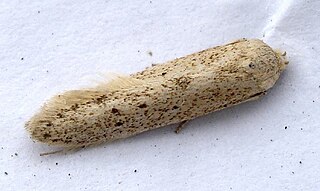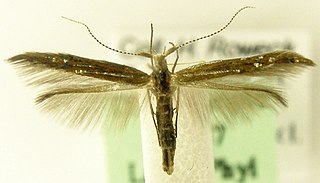Related Research Articles

Gelechioidea is the superfamily of moths that contains the case-bearers, twirler moths, and relatives, also simply called curved-horn moths or gelechioid moths. It is a large and poorly understood '"micromoth" superfamily, constituting one of the basal lineages of the Ditrysia.

The Coleophoridae are a family of small moths, belonging to the huge superfamily Gelechioidea. Collectively known as case-bearers, casebearing moths or case moths, this family is represented on all continents, but the majority are found in temperate areas of the Northern Hemisphere. They are most common in the Palearctic, and rare in sub-Saharan Africa, South America, and Australia; consequently, they probably originated in northern Eurasia. They are relatively common in houses, they seek out moist areas to rest and procreate.

The Batrachedridae are a small family of tiny moths. These are small, slender moths which rest with their wings wrapped tightly around their bodies.

Blastobasis is the type genus of the gelechioid moth family Blastobasidae; in some arrangements these are placed in the case-bearer family (Coleophoridae) as a subfamily. Within the Blastobasidae, the subfamily Blastobasinae has been established to distinguish the Blastobasis lineage from the group around Holcocera, but the delimitation is not yet well-resolved.

Holcocera is a gelechoid moth genus of the family Blastobasidae. There are about 70 described species.
Nasamonica is a genus of moths, belonging to the family Coleophoridae or Momphidae. It contains only one species, Nasamonica oxymorpha, which is found in Chad.

Coleophora ornatipennella is a small moth of the family Coleophoridae.
Coleophora squamosella is a moth of the family Coleophoridae. It is found in Europe, the Baltic states, the Caucasus, Russia and Turkey.
The pistol casebearer is a moth of the family Coleophoridae. It is found in North America, from Virginia to Kansas and northward to Canada. It is also known from California and Utah.
Coleophora euryaula is a moth of the family Coleophoridae. It is found in Egypt.
Coleophora protecta is a moth of the family Coleophoridae described by Walsingham in 1907. It is found in Lebanon, Algeria, Morocco and Tunisia.
Coleophora magnatella is a moth of the family Coleophoridae. It is found in Afghanistan and Iran.
Coleophora falkovitshella is a moth of the family Coleophoridae. It is found in Mongolia and Korea.
Coleophora hololeucella is a moth of the family Coleophoridae. It is found in Algeria and Egypt.
Coleophora echinacea is a moth of the family Coleophoridae. It is found in Mongolia.
Augasma aeratella is a moth of the family Coleophoridae. It is found in most of Europe. The habitat consists of open landscapes of forest-steppe and steppe biotopes.
Goniodoma auroguttella is a moth of the family Coleophoridae. It is found in southern Europe, European Russia and Asia Minor. The habitat consists of steppe and semi-desert biotopes.

Goniodoma limoniella is a moth of the family Coleophoridae. It is found in western Europe and the Mediterranean region.
Goniodoma nemesi is a moth of the family Coleophoridae. It is found in Croatia, Italy, Greece and Romania.

Metriotes lutarea is a moth of the family Coleophoridae. It is found in most of Europe and Turkey.
References
| Wikispecies has information related to Tocasta |
| This article on a moth of the subfamily Agonoxeninae is a stub. You can help Wikipedia by expanding it. |